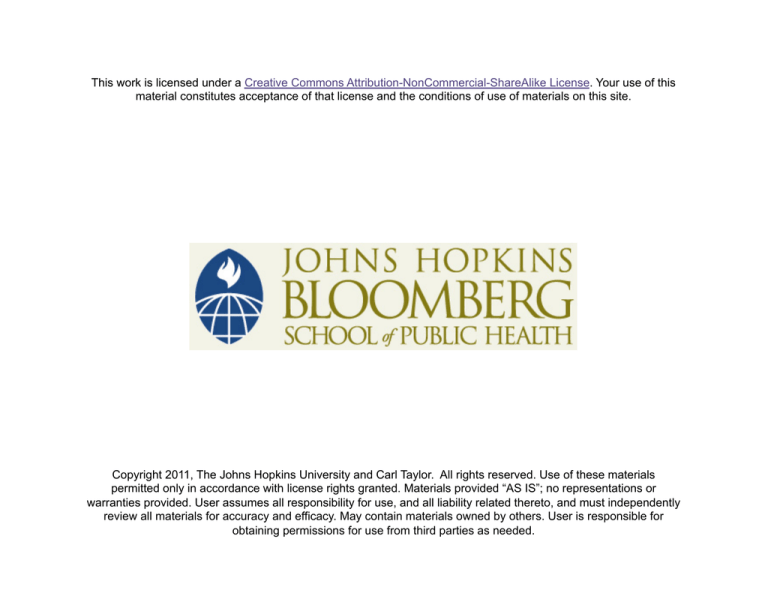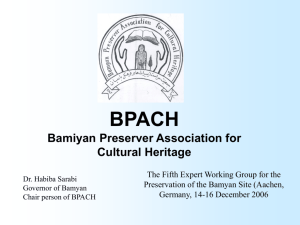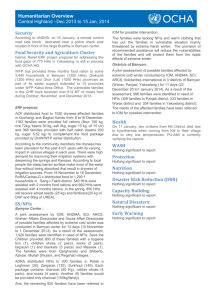
This work is licensed under a Creative Commons Attribution-NonCommercial-ShareAlike License. Your use of this
material constitutes acceptance of that license and the conditions of use of materials on this site.
Copyright 2011, The Johns Hopkins University and Carl Taylor. All rights reserved. Use of these materials
permitted only in accordance with license rights granted. Materials provided “AS IS”; no representations or
warranties provided. User assumes all responsibility for use, and all liability related thereto, and must independently
review all materials for accuracy and efficacy. May contain materials owned by others. User is responsible for
obtaining permissions for use from third parties as needed.
Section B
BPHS: Basic Package of Health Services: A One Year Pilot
Methodology
Total of 60 CHWs trained, 20 in each site, 1–2 per village
Average 50 households per CHW, 3,000 households, pop.: 21,000
70 WAGs, 10 women in a WAG; each covers about five families
Sample surveys of 332 households at baseline and 351 households
follow-up (MSH/LQAS surveys done with approximately 1.3 women
per household)
3
Regular CHW Visits
100
90
80
70
60
Baseline
Follow-up
50
40
30
20
10
0
Rostam
Syadara
Percent of households visited in each site in Bamyan showing different impact in pilot study
before survey in Rostam and rest of villages in Syadara
Data Source: Future Generations. www.future.org.
4
Antenatal Care
50
45
40
35
30
Baseline
Follow-up
25
20
15
10
5
0
Total
CHW
Doctor
Trained Dai
Role reallocation for continuing antenatal care and type of provider in Bamyan sites
Data Source: Future Generations. www.future.org.
5
Tetanus Toxoid
90
80
70
60
50
Baseline
Follow-up
40
30
20
10
0
Rostam
Syadara
Percent of women who received injections in each Bamyan site
Data Source: Future Generations. www.future.org.
6
Postnatal Care
60
50
40
Baseline
Follow-up
30
20
10
0
Rostam
Syadara
Percent of women receiving postnatal care in each Bamyan site
Data Source: Future Generations. www.future.org.
7
Pressure on Uterus
Percent of women who reported stopping severe pressure on uterus to get the baby out
quickly when normal labor slowed down in Bamyan
Data Source: Future Generations. www.future.org.
8
First Breastfeeding
Percent of women in Bamyan reporting starting time of breastfeeding
Data Source: Future Generations. www.future.org.
9
Exclusive Breastfeeding (Six Months)
80
70
60
50
Baseline
Follow-up
40
30
20
10
0
Percent of women in Bamyan reporting exclusive breastfeeding
Data Source: Future Generations. www.future.org.
10
Knowledge of Contraception
Percent of women in Bamyan interviewed
Data Source: Future Generations. www.future.org.
11
Source of Drinking Water
80
70
60
50
Baseline
Follow-up
40
30
20
10
0
Spring
Surface Water
Percent of households using specific water sources in Bamyan
Data Source: Future Generations. www.future.org.
12
Women’s Empowerment
80
70
60
50
Baseline
Follow-up
40
30
20
10
0
Overnight Permission
Important Decisions
Percent of women responding in Bamyan
Data Source: Future Generations. www.future.org.
13
CHWs Asked to Help in Deliveries
90
80
70
60
Baseline
Follow-up
50
40
30
20
10
0
Percent of CHWs in both sites in Bamyan
Data Source: Future Generations. www.future.org.
14
Summary Findings for Scaling Up
In the past three years, Afghanistan’s national BPHS program
achieved great success increasing basic health coverage by 77% in 13
provinces
Where coverage exists, CHW training can be shortened to maybe
one or two women’s empowerment workshops
However, maternal mortality ratios in remote provinces such as
Badakshan have some of the highest health disparities ever reported
- Maternal mortality ratios of over 6,000 per 100,000—presumably
the highest mortality is in the remaining 23%
This project showed that in remote villages, women responded most
eagerly to self-reliant empowerment
- In less than a year, they changed behavior and social norms
equivalent to the experience in the BPHS-NGO projects that
took two to three years to accomplish
15





